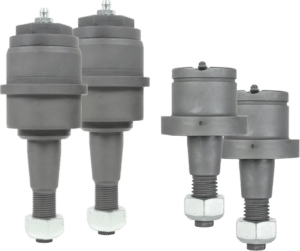Introduction
If you own a Dodge Ram 2500 or 3500, you’re driving a beast of a truck built for heavy-duty tasks. But even beasts have their weak points—and Ram truck ball joint failure tops the list for these trucks. Whether you’re hearing strange noises, noticing sloppy steering, or experiencing the dreaded “death wobble”, this post is here to guide you through the issue, the fix, and some premium upgrade options.
Symptoms of Ram Truck Ball Joint Failure
The common symptoms of Ram truck ball joint failure:
- Clunking or Popping Sounds
Your truck isn’t learning to beatbox—those sounds mean your ball joints are on their way out. - Loose or Wandering Steering
If your Ram suddenly feels like it’s had one too many drinks and can’t stay straight on the road, bad ball joints might be to blame. - Uneven Tire Wear
Keep an eye on your tires. Worn ball joints can throw off your alignment, leading to premature tire wear. - The Dreaded Death Wobble
For those who have experienced Death Wobble. You know how serious it can be. This isn’t a little steering shimmy you get in your prius. If you don’t have to check your drawers after then that ain’t it. When worn ball joints cause excessive play in the front end, you might experience violent steering wheel shaking—usually at highway speeds. The issue with death wobble is that its incredibly hard on your suspension and steering typically wearing out other components snowballing your automotive repairs if left unattended. Learn more about Death Wobble.
Why Ball Joint Repairs Are Pricey ($$$)
While there may be other symptoms, these are the most common:
- Labor-Intensive Process
Replacing ball joints isn’t a quick fix. This automotive repair involves removing the entire steering knuckle and sometimes a lot of persuasion to get the old joints out. - Special Tools Required
You’ll need a ball joint press, and if you’re DIYing it, you may end up questioning your life choices halfway through. - Premium Parts Cost More
While you can opt for stock replacements, most owners find it worth upgrading to heavy-duty ball joints from brands like Dynatrac, Carli Suspension, Synergy, or SPC. These parts are engineered to last longer and handle the stresses of off-road and towing applications.
The Axle Secret
When replacing ball joints, it’s smart to replace your axle seals at the same time. Why?
- The process to access ball joints involves removing the axle shafts, which is half the work for replacing seals. Doing both at once saves on labor costs later.
- Not only are you half way there… When removing the axles you disturb the seal and add an extra risk of causing a leak. Typically right after the repair is completed causing you to dive back into the project all over again.
- If a leak goes unnoticed Low Differential fluid can cause differential failure rather quickly.
Don't Forget the Alignment!
After replacing ball joints, your front-end alignment will be thrown off due to the new components
- Prevent uneven tire wear.
- Ensure proper handling and steering.
Upgraded Ball Joints: The Heavy-Duty Solution
Why settle for stock when you can upgrade? Here are some top options:
- Dynatrac ProSteer Ball Joints: Known for their durability and rebuildable design. Perfect for heavy towing or off-road use.
- Carli Suspension Ball Joints: Engineered for extreme conditions, offering smooth operation and long service life.
- Synergy HD Ball Joints: A popular choice among off-road enthusiasts for their strength and reliability and also rebuildable in vehicle.
- SPC Performance Ball Joints: The only adjustable option for a better alignment Adjustable and stronger - built to handle lifted trucks, ensuring proper geometry even with suspension modifications.

Conclusion:
Ball joint failure is a common automotive repair for Dodge Ram 2500 and 3500 owners, but it doesn’t have to be a nightmare. By recognizing the symptoms early, opting for quality replacements, and addressing related components like axle seals and alignment, you can keep your truck running strong for years to come. And if you’re upgrading, investing in heavy-duty ball joints will save you from future headaches—and even the dreaded death wobble.

